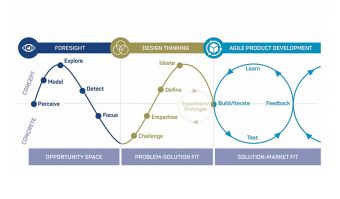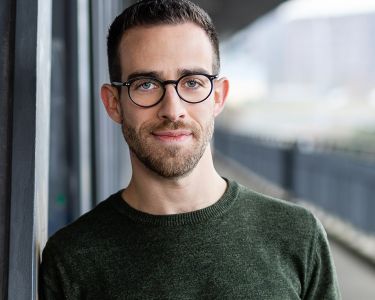
The future belongs to the creative
Hamburg Kreativ Gesellschaft

The future belongs to the creative
How companies use the potential of the creative industries to stay innovative
Tesla is not a car manufacturer. Tesla is a software company that also makes cars. The car is one product of many, limits are not set. Tesla founder Elon Musk always thinks in terms of opportunities and possibilities, but never in terms of traditions. And that’s new. These are new realities of life that now pose major challenges for numerous companies, especially when it comes to developing innovations. Because tomorrow’s innovations are at odds with today’s industries. In this piece Hamburg Kreativ Gesellschaft mbH shows how looking into the future of content and creative industries is a tool to improve innovation today—across all industries.
The automotive industry is currently experiencing new realities very accutely, especially as it is in the midst of the biggest transformation process in its history. If we leave aside the most obvious challenge—namely the technical component—from the combustion engine to the emission-free automobile, we see a development whose dimensions should not be underestimated: User behaviour is changing dramatically. Not everyone wants their own car and car-sharing is becoming more and more common. In addition, there is a growing environmental awareness, but also social areas of conflict (for example, available and affordable housing) are displacing the supposed self-evidence of owning a car.
Picture above: Welcome at Play Day Final, Copyright by Laura Müller
Picture left: Demo Prototype, Copyright by Laura Müller
The image of the future
The new mobility—especially in large cities—is creating an acute need for innovation in the industry far beyond the ecological-technological sphere. Thus, data- and content-based business models are becoming a central component of a sustainable business model. For the automotive industry (as for many other industries), it will also be a matter of crossing previous industry boundaries and working in an interdisciplinary manner in order to remain capable of innovation. Above all, however, companies will have to deal more and more intensively with the future. We often still cling to the idea that we can’t determine the future, but that it will be determined. But that may prove to be a mistake. Instead, we will have to create tools and methods to really look ahead. Only in this way will the picture emerge toward which we must work.
In 2019, nextMedia.Hamburg and the Cross Innovation Hub (part of Hamburg Kreativ Gesellschaft mbH) developed Content Foresight, a unique, Europe-wide tool for bringing together different perspectives, different know-how, different inspirations, and also very different creative approaches in a media- and technology-diffuse world. Content Foresight has since proven to be a highly effective method for making reliable predictions for the content industry based on creative input and interdisciplinary collaboration with other industries. Just one example: If autonomous driving becomes established in the medium term, mobility providers in particular will have to become much more involved in other business areas than before. Because when the car drives itself, drivers will have time and space for new forms of occupation, new forms of media use. This, in turn, requires creative and content-related input, i.e., content! And that promises enormous potential for creative and media professionals.
Content Foresight promotes creative innovation work
The Content Foresight innovation program we developed is a tool for testing new applications and future business areas for the content and media industry. Content Foresight is based on the research-proven methods of Strategic Foresight and was adapted and further developed by us for the content industry. Beyond the productive interdisciplinary setting, Content Foresight thrives on impulses, ways of thinking and specific skills of external creative professionals who are included in the innovation process. These professionals come from the different submarkets of the creative industries to form a so-called „pool of creatives“. As part of the project, they are not only paid for their contributions, but also meet the participating companies at eye level and can build a new network. Applicants so far have been people from the various submarkets of the creative industries, with a focus on different digital competencies, i.e. software development, PC games, interaction/UX design, sound, virtual and augmented reality and storytelling.

The new renaissance of the creative
The „New Renaissance“ that is emerging now, at the beginning of the 21st century, will have to leave behind the purely growth-oriented, resource-consuming innovations and thus bring about socially desirable changes. The term Renaissance was chosen deliberately because the „old“ Renaissance, i.e. the period between the 14th and 16th centuries, led to a boost in innovation in various areas; it was the time when technology and art, science and creativity merged. We want to build on this—especially in times of the COVID-19 pandemic—in order to contribute to overcoming the crises of our time. Because it is a sector that we hold in high esteem which is becoming the driving force behind this movement: the creative industries. It seems to be the sustainable winner in the merging of all areas of our lives. It is characteristic of the new renaissance that problems and crises can be solved more and more effectively across all areas and sectors. What was once separate, the creative person is able to connect with bridges and lead to innovative solutions. The creative industries are now an innovation-driving sector of the economy that is successfully leading other economic players into the new renaissance.
Picture left: Foresight Process / Copyright: Rohrbeck Heger GmbH
In recent years, the content-producing players in the creative industries—the publishing, media and music sectors, and of course journalism—have been the first sectors to digitise and transform themselves and they continue to do so. This is because the traditional media companies are facing a permanent change in terms of the behaviour and demands of the users of their products and services. Subscriptions are becoming memberships, content providers are becoming curators, and monothematic offerings are becoming lifeworlds and services that must be able to be mapped seamlessly on all platforms. As a result, data-driven business models are moving further into the foreground. Diversified business models must be found to suit the sovereignty, flexibility, and individuality of these users. With the credo of „meeting users where they are“, the industry has had a self-imposed target since the 2010s and continues to be dependent on technology and data, and thus on monopoly-like infrastructure providers, such as platforms, software and hardware providers. One also observes within the content industry an increasing merger of different providers into cooperations, alliances or mergers—and with it an increasing willingness to innovate, indeed an innovative power.
In other words, the content industry has the best prerequisites for the new renaissance.
Picture right: Status Quo, Copyright by Laura Müller

Looking to the future promotes the innovative power of today
In our view, Strategic Foresight is therefore the most suitable method for bringing together areas that are supposedly alien to one another to exchange ideas and find concrete solutions to their current and future challenges. After all, looking into the future promotes innovation today. However, companies still too often face major hurdles in perceiving and exploiting this potential. But simply dealing with a time horizon of five years is still unusual in companies. In order to better cope with the approaching, rapid changes and not only remain capable of acting, but also to be able to shape the future, even more courage and willingness to take risks will be required in the future.
This willingness also includes cooperation across industry and company boundaries. Most industries and management strategies still seem to be unfamiliar with open and cross-innovation processes. Yet the increasing complexity of our world is due not least to the convergence of markets and industries. So while classic competitive thinking can make long-term innovation even more difficult, it is often neutral and supra-organisational approaches that can create new spaces of opportunity and change mindsets. And above all, the involvement of the creative industries creates additional potential. Their ways of thinking and working not only provide new impetus for the innovation process itself, but are also becoming indispensable in view of the need to shape a new, sustainable, equitable future.
Picture below: Michail Paweletz reads 2034, Copyright: Laura Müller
For the practical application of content foresight, we rely on the following approaches:
1. With a cross-innovation approach, we create a setting that is considered to be particularly conducive to innovation and can thus bring two different sectors into innovation work in a targeted manner, in which we work in a user- and solution-oriented manner with the help of methodologically sound processes.
2. The focus is on methods of strategic foresight, which not only look at the development of possible futures, but also specifically enable the identification of so-called opportunity spaces and thus recommendations for action to successfully anticipate them.
3. In the subsequent design thinking process, concrete prototypes are developed alongside the joint visions. In addition, we rely on special impulses in these processes through targeted collaboration with actors from the creative industries.
4. As a public provider, we also act as a neutral player in this process and create trust among the companies involved and, where applicable, among competing companies.
With this setting, in a format that is unique in Europe, we are not only creating an experimental area for concrete approaches to current and future challenges, but also new impulses and foundations for the sustainable innovative capacity of the participating players.

So what do the possible futures look like when actors from the content industry work together with mobility experts? Where are the opportunity spaces? Content Foresight – Mobility by nextMedia.Hamburg and the Cross Innovation Hub produced the following triad of innovations:
Business ideas using the example of the content & mobility interface
I.
2024. For a time horizon of five years, the Hamburger Morgenpost and Schwan Communications have developed a tangible solution for linking content and mobility offers that can already be implemented with current technologies. The prototype Digital Guided Tour /HAM offers users multimedia content (video, audio, text) that functions in a wide variety of means of transportation, is coupled with them, and whose playout is adapted to the means of transportation. In this way, it not only offers content providers new distribution channels, but also creates incentives for the use of public and/or climate-friendly means of transport in the city—from e-scooters to sharing offers and public transport. This applies not only to local residents, but also to the more than seven million tourists who visit the Hanseatic city every year, thanks to the integration of tourist attractions and historical content.
II.
2029. The project team of MaibornWolff and pilot Hamburg planned the next step: With S.T.E.P—the Seamless Travel Experience Platform—mobility and entertainment/information are individually tailored to the user. Instead of having to actively choose from countless options how to get from A to B and which content can be consumed on the way, a digital twin creates situationally optimal decision bases for seamless travel planning. The blockchain-based application already developed promises all-in-one processing. In a planning horizon of about five to 10 years, app chaos on smartphones will then be as much a thing of the past as login madness. Through a public-private ownership model, in which the public sector acts as a regulator, a critical mass of services and users* can be aggregated, which can fully keep an eye on the optimisation of passenger transport, independent of the economic success of individual providers.
III.
2034. What’s next? How do we envision mobility and content when blockchain technologies and AI-supported systems have long since become part of our everyday lives and our data precedes our decisions? Representatives from NDR, Axel Springer, HOCHBAHN, IAV, ITS Hamburg 2021 and Wunder Mobility give us an impression of this in their concept of experiential mobility. In the sense of a pre-prototype, the team developed a vision of mobility in a time horizon of about 15 years, which considers social (e.g. environmental protection, education), political (e.g. data sovereignty), technological (e.g. autonomous driving, artificial intelligence as technology serving people, digital identity) and individual aspects (e.g. consumption, convenience) in equal measure and integrates them into product and service scenarios.
The vision, spoken by ARD news anchor Michail Paweletz, is publicly available here.
Open even to unfamiliar input
So… You can’t do it without looking into the future. But… Everyone looks at the future differently. To find the best solution together, it is crucial to organise an exchange—and to learn from each other. This is the only way to create innovations.
If you want to be innovative tomorrow, you have to be open today, even for unusual input—and above all for new content!
Quotes from company representatives:
Dr. Johanna Leuschen, Head of NDR Audio Lab (Norddeutscher Rundfunk)
„We believe that in the future we will always get the content that is best suited to our mood, in the current mobility situation, in the time available. The keyword here is personalisation. The user focus is and will remain essential. For journalism, AI could be useful in an assisting role: Tasks that do not necessarily require creativity (weather, election or sports results) could be taken over by algorithms. Then journalists could devote themselves entirely to creative and research-intensive topics. And we assume that companies in general, not just content providers, should look at an audio and voice strategy and tailor their offerings for a voice-driven world in the long term. Discoverability is going to be a big challenge going forward.“
Nicolas Meibohm, Head of Connected Car (Axel Springer SE)
„We often still cling to the idea that we can’t determine the future, it will be determined. But that is exactly the mistake. So now, once we really look ahead, we get a picture we can work toward. This program has set a benchmark and proven that interdisciplinary collaboration really makes sense.“
Hendrik Menz, ehemals Director Business Development (pilot Screentime GmbH)
„It takes a wide range of relevant expertise and value-added fields to absorb the necessary complexity of a holistic approach.“
Dr.Nina Klaß
Dr. Nina Klaß is an expert in content and tech innovation. She leads nextMedia.Hamburg (part of Hamburg Kreativ Gesellschaft mbH) where she developed and executed a range of highly recognized innovation programs such as the Content Foresight project. Previously, she was head of digital product marketing & sales management at SPIEGEL Group. She is active as funding committee member, jury and advisor of innovation programs worldwide.
Picture © Oliver Reetz

Egbert Rühl
Egbert Rühl has been active as a cultural and arts facilitator his whole life – in many different genres and functions. He is the managing director of the Hamburg Kreativ Gesellschaft. In this role, he is responsible for strategy and tactics, guidance and moderation, budget compliance, and contact with politics and administration.
Picture © Oliver Reetz

Marc Eppler
Marc Eppler is responsible for nextMedia.Hamburg’s partner management and he operates programs such as Content Foresight. Previously, he worked at the Franco-German culture channel ARTE in Strasbourg.
Picture © Oliver Reetz

